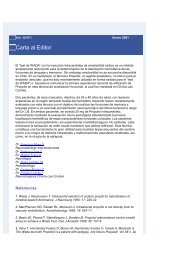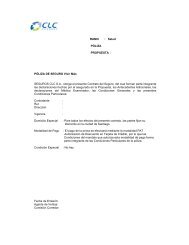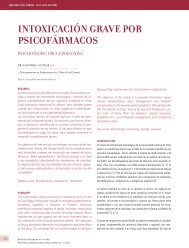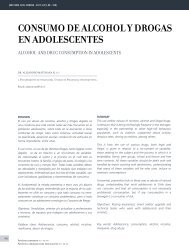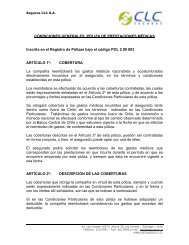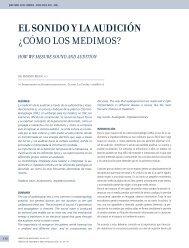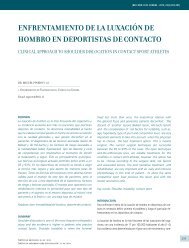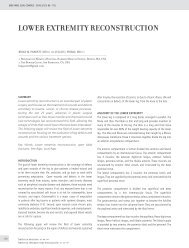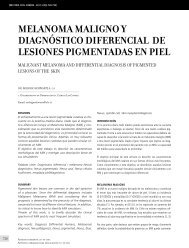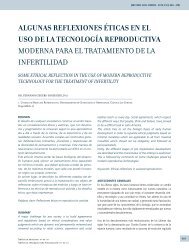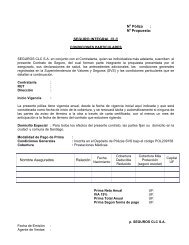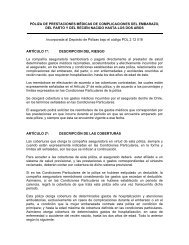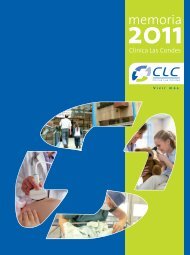Hijos adultos mayores al cuidado de sus padres, un fenómeno ...
Hijos adultos mayores al cuidado de sus padres, un fenómeno ...
Hijos adultos mayores al cuidado de sus padres, un fenómeno ...
Create successful ePaper yourself
Turn your PDF publications into a flip-book with our unique Google optimized e-Paper software.
[REV. MED. CLIN. CONDES - 2012; 23(1) 42-48]<br />
Ev<strong>al</strong>uación <strong>de</strong> riesgos quirúrgicos<br />
y manejo post cirugía <strong>de</strong>l adulto<br />
mayor <strong>de</strong> 80 años<br />
EVALUATION OF SURGICAL RISK AND POST-SURGICAL TREATMENT OF<br />
ELDERLY OVER 80 YEAR<br />
Dr. Víctor Hugo Carrasco M. (1), DR. Juan Ignacio Quintero B. (1), (2)<br />
1. Hospit<strong>al</strong> Clínico Universidad De Chile.<br />
2. Hospit<strong>al</strong> <strong>de</strong> Urgencias Asistencia Pública.<br />
Email: vcarrasco@redclinicauchile.cl<br />
RESUMEN<br />
Chile vive <strong>un</strong> envejecimiento acelerado, con expectativas<br />
<strong>de</strong> vida en aumento. Por otra parte, la ten<strong>de</strong>ncia a operar<br />
<strong>adultos</strong> <strong>mayores</strong> ha sido mayor que la esperada sólo<br />
por el envejecimiento <strong>de</strong> la población. Sin embargo, las<br />
complicaciones perioperatorias son más frecuentes en los<br />
ancianos. Entre otras razones <strong>de</strong>staca su mayor comorbilidad<br />
y el fenómeno <strong>de</strong> “homeoestenosis”. Todo esto <strong>de</strong>termina<br />
que el paciente anciano requiera ev<strong>al</strong>uaciones y <strong>cuidado</strong>s<br />
especi<strong>al</strong>es en el peri-operatorio. Esta revisión explica y discute<br />
el rol <strong>de</strong>l Médico Geriatra y <strong>de</strong> la Ev<strong>al</strong>uación Geriátrica Integr<strong>al</strong><br />
en reducir la morbi-mort<strong>al</strong>idad peri-quirúrgica <strong>de</strong>l adulto<br />
mayor, especi<strong>al</strong>mente <strong>de</strong>l mayor <strong>de</strong> 80 años; res<strong>al</strong>tando los<br />
componentes <strong>de</strong> comorbilidad, medicamentos, f<strong>un</strong>cion<strong>al</strong>idad<br />
y exámenes complementarios. También se discuten las<br />
princip<strong>al</strong>es medidas a consi<strong>de</strong>rar en el postoperatorio.<br />
P<strong>al</strong>abras clave: Geriatría, v<strong>al</strong>oración geriátrica, cirugía,<br />
ancianos y <strong>cuidado</strong>s peri operatorios.<br />
SUMMARY<br />
Chile is experiencing a process of accelerated aging with<br />
increasing in life expectancies. On the other hand, the<br />
ten<strong>de</strong>ncy to operate el<strong>de</strong>rly patients has been greater<br />
than that just explained by that of the aging population.<br />
Nevertheless, peri-operative complications are more<br />
common for the el<strong>de</strong>rly than for the yo<strong>un</strong>ger patient.<br />
Among other reasons, they have more comorbidities and<br />
the “homeoestenosis” phenomenon. All this explains why<br />
the el<strong>de</strong>rly patient needs speci<strong>al</strong> care and ev<strong>al</strong>uation in the<br />
peri-operative period. This review discuses and explains the<br />
importance of the Comprehensive Geriatric Assessment and<br />
the Geriatrician in reducing morbidity and mort<strong>al</strong>ity in the<br />
el<strong>de</strong>rly patient, especi<strong>al</strong>y over 80 years of age; emphasizing<br />
comorbidity, medications, f<strong>un</strong>ction<strong>al</strong>ity and lab testing. We<br />
<strong>al</strong>so discuss the princip<strong>al</strong> measures that must be consi<strong>de</strong>red<br />
on the postoperative period.<br />
Keywords: Geriatrics, geriatric assessment, surgery, aged,<br />
perioperative care.<br />
INTRODUCCIÓN<br />
Chile vive <strong>un</strong> envejecimiento acelerado, con <strong>un</strong>a ten<strong>de</strong>ncia marcada a la inversión<br />
<strong>de</strong> la pirámi<strong>de</strong> <strong>de</strong>mográfica (Figura 1). La expectativa <strong>de</strong> vida para<br />
el quinquenio 2010 - 2015 es <strong>de</strong> 76 y 82 años para hombres y mujeres<br />
respectivamente. Siendo el segmento etario que más crece y el que proyecta<br />
mayor crecimiento el <strong>de</strong> 75 años y más. De hecho, el número personas<br />
<strong>mayores</strong> <strong>de</strong> 75 años casi se ha duplicando entre el período 2000 y 2015<br />
(1). La expectativa <strong>de</strong> vida ha aumentado mucho más <strong>al</strong>lá <strong>de</strong> lo que se esperaba<br />
en proyecciones <strong>de</strong>mográficas <strong>de</strong> hace pocas décadas. En concreto,<br />
para cada edad hay <strong>un</strong>a expectativa <strong>de</strong> vida <strong>de</strong>mográficamente <strong>de</strong>finida.<br />
Por ejemplo, <strong>un</strong>a persona <strong>de</strong> setenta años hoy posee <strong>un</strong>a expectativa <strong>de</strong><br />
42<br />
Artículo recibido: 24-10-2011<br />
Artículo aprobado para publicación: 06-12-2011



